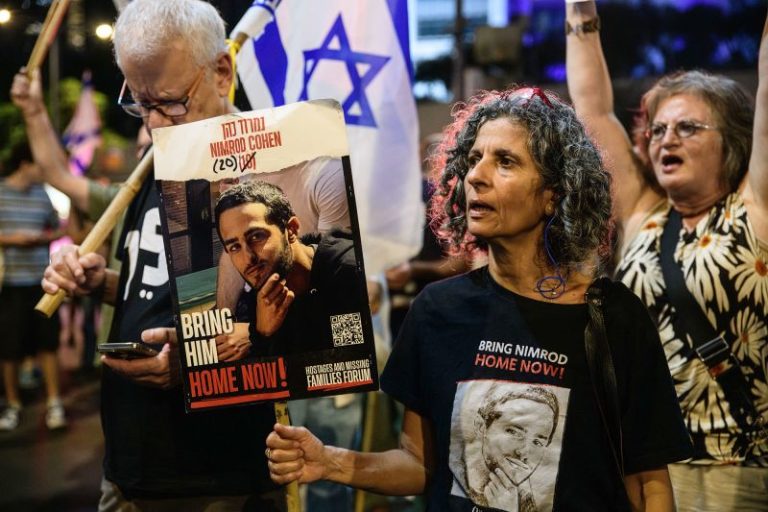The shopfronts are decked out in white, blue and red, with Chinese and Russian flags hanging side by side from the ceiling. Waist-high Russian dolls greet customers at the entrance. Inside, shelves are stocked with an array of Russian goods – from chocolates and cookies to honey and vodka.
In China, pop-up stores specializing in Russian-made products have become an increasingly common sight. Their proliferation has left some residents puzzled, with many on Chinese social media questioning why these stores seem to have sprung up overnight.
Thousands of such stores have opened across the country in recent years, tapping into the Chinese public’s affinity for Russia and deepening trade ties between Beijing and Moscow since Vladimir Putin’s full-scale invasion of Ukraine began in 2022.
China has become a critical economic lifeline for sanctions-hit Russia, with bilateral trade reaching record highs year after year. While cheap Russian oil, gas, and coal dominate China’s imports, Russian food products – such as ice cream, sweet biscuits and milk powder – have also risen sharply in popularity.
Chinese businesses have rushed to capitalize on the booming demand.
More than 2,500 new companies involved in the trade of Russian goods have been registered since 2022, according to China’s business records, with nearly half registered in the past year alone. Around 80% of the new firms that rushed to cash in on the craze remained in operation as of this month, business registration records show.
Most of these companies are based in Heilongjiang, the northeastern province bordering Russia, though in the past two years they’ve spread in other provinces.
More than aquatic and agricultural products, which make up the bulk of China’s food imports from Russia, it is Russian-branded chocolates, biscuits and milk powder that have captured the attention of Chinese consumers, appealing directly to the “Made in Russia” brand promoted by Moscow.
The stores’ explosive growth – dubbed “crazy” by a Chinese state media report – has also sparked scrutiny over the authenticity of their products. Investigations by media outlets and influencers alike have revealed that some Russian branded items were actually made in China, prompting authorities to crack down on misleading labeling and advertising.
At a Russian goods store in downtown Beijing in February, a shop assistant arranged rows of neatly packaged candies, biscuits, and milk powder – some of the store’s most popular items.
“The best seller is Russian honey – it’s a big hit. And this chocolate is pure. They’re all very good,” she said, gesturing toward a wide selection of chocolates.
In the background, a loudspeaker played a looping message, welcoming customers to the “Russian Goods Pavilion” and hailing Russian products for their “healthiness, natural ingredients, and high quality.”
“This is not only a platform for selling Russian products but also a window showcasing Russian culture and charm,” it declared.
Liang Jinghao, a tourist from the northern Shanxi province, said he had seen many similar Russian goods stores back home. “Russia is a very good country, with a vast land area and rich resources, and its people are also very friendly,” he said.
Su, 20, has opened three Russian goods stores in Pingliang, a small city in the northwestern province of Gansu, since September last year.
“China and Russia have maintained pretty good relations in recent years, and personally, I have a fairly positive view of Russia as a country,” she said.
Su’s stores also sell products from Sri Lanka and Australia, but they were far less popular, she said. “I think Russian products are a better fit for the local taste,” she said.
As Putin wages his grinding war on Ukraine, China and Russia have grown closer than ever, accelerating a trend driven by their shared animosity toward the US and common goal of pushing back at a Washington-led global order.
Russia and its autocratic leader also enjoy wide popularity among the Chinese public.
In a poll released last year by the Center for International Security and Strategy at Beijing’s Tsinghua University, 66% of respondents expressed “very favorable” or “somewhat favorable” views toward Russia. By contrast, about 76% expressed “unfavorable views” toward the United States.
The made-in-Russia craze can be traced back to early 2022, according to Chinese state media.
Just days after Russian tanks rolled into Ukraine, the “Russian State Pavilion” – an e-commerce store endorsed by the Russian embassy in China – went viral on Chinese social media. Shoppers rushed to snap up everything from candies to tea sachets, spending nearly 6 million yuan ($826,000) on Russian goods within three days, according to Chinese media reports at the time.
In a short video posted on the online store, a Russian business representative toasted “the friendship of old Chinese friends under this complicated and constantly changing international situation.”
By April 2023, more than 300 Moscow-based companies had joined Chinese e-commerce platforms, including Taobao and JD, according to Russian state news agency Sputnik, citing the Moscow Export Center.
The following year, the first “Made in Russia Festival and Fair” debuted in Shenyang and Dalian, the two biggest cities in Liaoning province in northeast China. The event was organised by the Russian Export Centre – a state-owned development institute – with support from Moscow and the provincial government.
More than 150 Russian companies participated in the week-long event, selling $2.3 million of Russian goods to Chinese consumers online and offline, Sputnik reported, citing the Russian Export Center. Three more such fairs have since been held, including in the southwestern metropolis of Chengdu.
The Russian Export Center has authorized eight official retail stores in China under the “Russian State Pavilion” brand. However, these outlets are vastly outnumbered by thousands of unofficial stores capitalizing on the surging demand for Russian products.
Scrutiny and backlash
As their popularity grows, the unofficial stores have also come under greater scrutiny from Chinese consumers and media, especially over the quality and authenticity of the goods sold there.
Late last year, Chinese shoppers took to social media to complain that some products labeled as Russian for sale at the stores were in fact made in China and other countries, including Malaysia.
A report by state-affiliated Jiemian News found a significant portion of food products sold at Russian goods stores – such as bread, sausage and milk powder – were produced in factories in northeastern China.
On Douyin, China’s version of TikTok, Russian influencers based in China rushed to expose what they called “fake Russian goods.”
“I’ve never seen these candies in Russia. The packaging is all fake,” a Russian Douyin user said.
“There’s absolutely nothing like this in Russia,” said another, holding a sausage at a store in Shanghai, while a shopkeeper could be heard in the background asking her to stop filming.
The Russian embassy in China also weighed in, warning Chinese customers against “counterfeits” disguised as Russian goods. “These products often do not meet quality requirements and are different from similar products produced in Russia, but Russian words are used on the packaging to imitate the Russian origin,” it said in a statement.
Following the outcry, market regulators in Shanghai launched two rounds of inspections on 47 Russian goods stores in the city. Seven of them were accused of falsely advertising themselves as “state pavilions,” misleading customers into believing they have official backing; others created “highly misleading impressions” about the origins of their products, the regulators said in a statement in January.
Some stores were ordered to close, while others were fined and required to label domestically produced goods more clearly. Other cities soon followed suit with similar inspections.
Despite the controversy, the popularity of Russian goods is driving more stores to open in China, including official ones.
The Russian Export Center said in February it plans to set up as many as 300 Russian goods stores with Chinese partners across the country before the end of the year.
At this year’s “Made in Russia Festival and Fair” in Shenyang, Veronika Nikishina, director general of the Russian Export Center, offered a tip for distinguishing authentic Russian products from counterfeits.
Genuine goods carry a dove-shaped “Made in Russia” label on their packaging, with Russia clearly marked as the country of origin, she explained.
“We sincerely hope that all Chinese consumers can purchase authentic, high-quality Russian-made products,” Nikishina said.
This post appeared first on cnn.com










